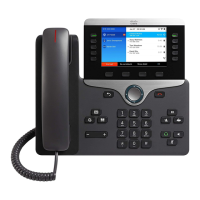The Cisco IP Phone 8861 and 8865 manage the scanning and roaming events.
The roaming trigger for the majority of roams should be due to meeting the required RSSI differential based on the current
RSSI, which results in seamless roaming (no voice interruptions).
For seamless roaming to occur, the Cisco IP Phone 8861 and 8865 must be associated to an access point for at least 3 seconds,
otherwise roams can occur based on packet loss (max tx retransmissions or missed beacons).
Roaming based on RSSI may not occur if the current signal has met the strong RSSI threshold.
Fast Secure Roaming (FSR)
802.11r / Fast Transition (FT) is the recommended deployment model for all environment types where frequent roaming occurs.
Cisco Centralized Key Management (CCKM) is also supported, but requires 802.1x authentication.
802.11r (FT) and CCKM enable fast secure roaming and limits the off-network time to keep audio gaps at a minimum when on
call.
802.1x or PSK without 802.11r (FT) and 802.1x without CCKM can introduce delay during roaming due to its requirement for
full re-authentication. WPA and WPA2 introduce additional transient keys and can lengthen roaming time.
802.11r (FT) and CCKM centralizes the key management and reduces the number of key exchanges.
When 802.11r (FT) or CCKM is utilized, roaming times can be reduced from 400-500 ms to less than 100 ms, where that
transition time from one access point to another will not be audible to the user.
There are two methods of 802.11r (FT) roaming.
Over the Air
The client communicates directly with the target access point using 802.11 authentication with the FT authentication
algorithm.
Over the Distribution
The client communicates with the target access point through the current access point. The communication between
the client and the target access point is carried in FT action frames between the client and the current access point via
the WLAN controller.
802.11r (FT) utilizing the Over the Air method is the recommended fast secure roaming model to deploy.
Since the 802.11r (FT) plus Over the Distribution method requires connectivity to the currently associated access point, this
method may not work well if the phone is not always able to communicate with the current access point as well as the target
access point, which could occur in non-open environments if line of sight to both the current access point and the target access
point can not be retained when a roaming event occurs.
The Cisco IP Phone 8861 and 8865 support 802.11r (FT) with WPA2-PSK or WPA2 and CCKM with WPA2 or WPA.

